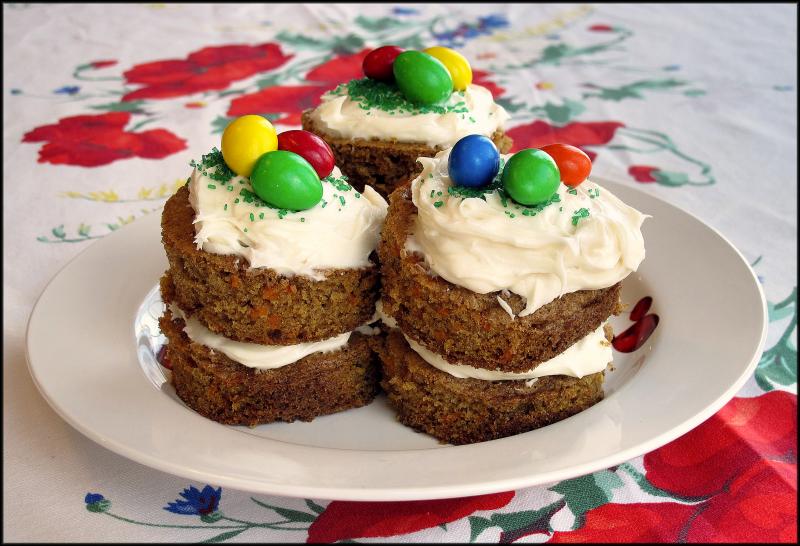Carrot cake for Easter dessert is a perfect match
For the past few weeks, my inbox has been filled with advertisements from restaurants and specialty markets inviting me to purchase an Easter meal. Offerings range from “still warm from our ovens” to “ready to bake in your oven.” Some include multiple courses, while others feature an elaborate entrée with sides. Although I’m not sure which way we’ll go this year, I have already selected dessert – carrot cake.
This rich treat enjoys a well-deserved reputation for decadence and has been the focus of much debate about its origins. Depending on which food historian you consult, you will either learn that carrot cake has been around for centuries or that it was “invented” in Germany or Poland in the 20th century. In light of all the conflicting information, I decided to consult what seemed to be a reliable source, the Carrot Museum.
This virtual collection covers all things related to the carrot. The website even has a floor plan, modeled after the layout of many physical museums, with sections for New Additions and History. As for carrot cake, the curators offer a chronological journey through the evolution of what we today think of as carrot cake: sweet, rich, highly spiced layered cake frosted with cream cheese icing.
During medieval times, when sugar was a costly commodity, carrots were used to sweeten puddings. The word “pudding” originally referred to a sweet or savory course with a custard-like consistency that was baked in a dish or pastry shell. The next stage in the evolution of carrot pudding was boiling or steaming the mixture into a more solid form. Eventually, the ingredients, baking technique and addition of frosting morphed into today’s familiar cake.
One of the more humorous aspects of the history of carrot cake was the time it spent on a list of “healthy” options for dessert. Somehow, food writers thought the inclusion of grated vegetables made carrot cake a better choice than a chocolate brownie, for example. However, between the oil in the batter and the cream cheese in the frosting, the descriptor “healthy” doesn’t spring immediately to mind.
As we look through the various urban legends about carrot cake, one thing is clear: It was not invented in the 20th century. Carrot cake was served to George Washington in 1783 at Fraunces Tavern in New York City on British Evacuation Day at the end of the Revolutionary War. Recipes for carrot cake appear in the earliest cookbooks published in the 18th century, and carrot pudding recipes appeared centuries earlier in both Asia and Europe.
As for recipes, I have included my version of carrot cake, which makes two somewhat thin layers, frosted with cream cheese icing. One caveat is to make sure the baking soda is evenly distributed in the batter, which is why I sift the dry ingredients together before adding the liquids. If there is too much baking soda or pockets of it, the carrots will turn green.
To make these mini-cakes for Easter, use a cookie cutter to create small rounds, making sure to ice each layer after you’ve cut them. Decorations here are green sprinkles for “grass” and almond M&Ms for “eggs.” If you’d like to experience how those medieval carrot puddings might have tasted, try the Indian confection gajar ka halwa, made with carrots, milk, ghee and cardamom. Happy Easter!
Carrot Cake
1 1/3 C flour
1 C sugar
1 1/2 t baking soda
1 t baking powder
1 t cinnamon
1/2 t ground cloves
1/2 t ground nutmeg
1/2 t ground allspice
1/2 t salt
3 eggs
1/2 C olive oil
1 1/2 C shredded carrots
Preheat oven to 350 F. Coat the insides of two 9-inch round baking pans with nonstick cooking spray; set aside. Sift the dry ingredients into a large bowl, then whisk together to ensure even distribution. In a small bowl, whisk the eggs until smooth. Stir in the olive oil and whisk to combine. Fold the egg mixture into the dry ingredients using a spatula. Stir in carrots. Pour batter into prepared pans and bake until a tester comes out clean, about 25 minutes. Frost with cream cheese icing.
Cream Cheese Icing
8 oz cream cheese
1/2 C butter
2 t vanilla
3 C confectioners sugar
Beat the cream cheese and butter together until smooth. Beat in vanilla. Gradually add the confectioners sugar and beat to combine. Yield: 2 C icing.
Gajar ka Halwa*
1 lb carrots
2 1/2 C whole milk
1/2 t cardamom seeds
1/3 C sugar
3 T ghee or 4 T melted butter
chopped almonds, for garnish
Shred the carrots on a box grater. Place 4 C shredded carrots in a heavy skillet (not nonstick). Crush cardamom with a mortar and pestle or spice grinder. Add milk and cardamom to the skillet. Cook over medium, stirring constantly until all the liquid is absorbed, about 40 minutes. Stir in sugar and ghee, mixing well to combine. Cook until heated through, about another 10 minutes. Serve warm, garnished with chopped almonds. *Adapted from the New York Times.






















































